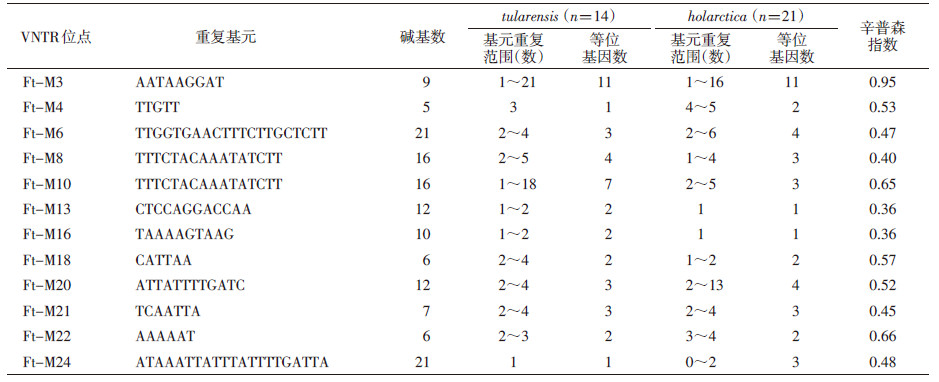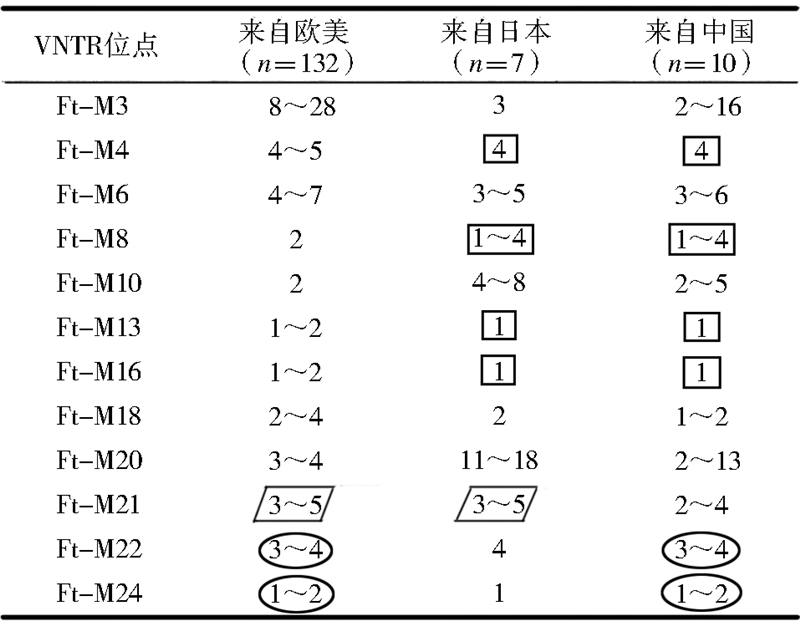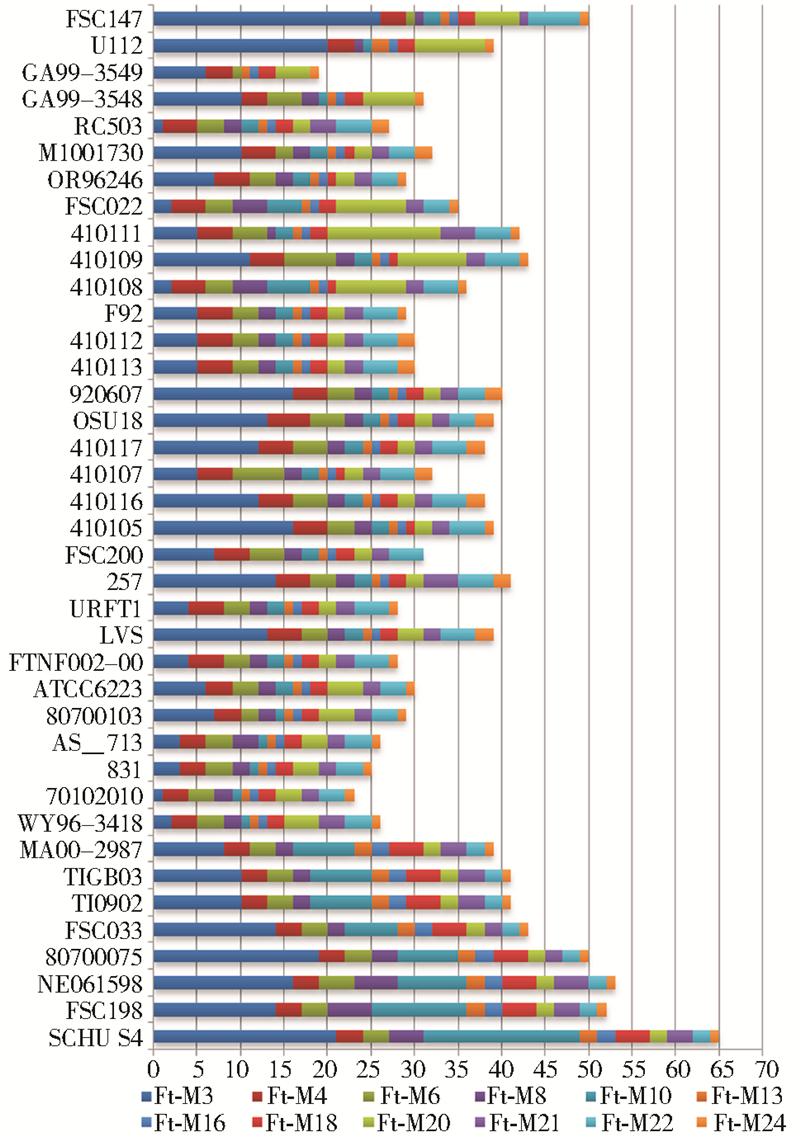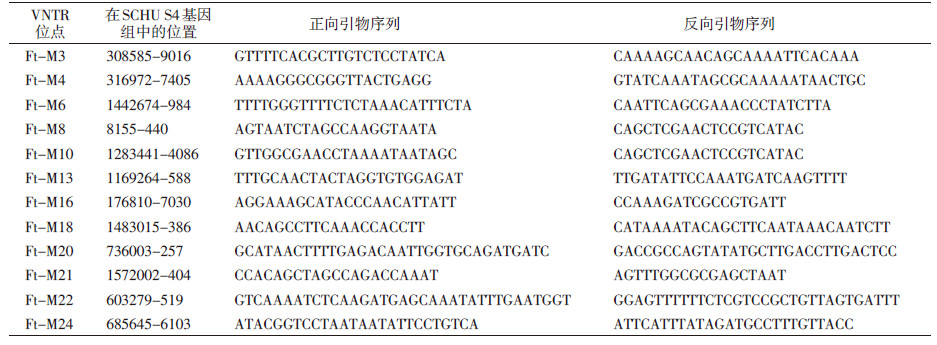文章信息
- 王艳华, 彭遥, 夏连续
- WANG Yan-hua, PENG Yao, XIA Lian-xu
- 中国土拉弗朗西斯菌数目可变串联重复多态性位点特有重复数的研究
- Studies on the unique repeat numbers of the VNTR in Chinese Francisella tularensis
- 中国媒介生物学及控制杂志, 2015, 26(6): 541-544
- Chin J Vector Biol & Control, 2015, 26(6): 541-544
- 10.11853/j.issn.1003.4692.2015.06.001
-
文章历史
- 收稿日期: 2015-06-29
- 网络出版时间: 2015-10-14 14:52
土拉弗朗西斯菌(Francisella tularensis,土拉菌)是一种具有较强传染性的胞内寄生菌,能够引起人和动物土拉热,也叫野兔热,主要通过媒介昆虫在哺乳动物和人之间传播。土拉热主要是由subsp. tularensis(A型)和subsp. holarctica(B型)引起,是一种在北半球流行的细菌性动物传染病。人们对于土拉菌的认识不仅仅限于它的表型特征,近年来新发展起来的基因分型技术,如脉冲场凝胶电泳(PFGE)、插入缺失标记分析(INDEL)、多位点可变数目串联重复分析(MLVA)、多位点序列分型(MLST)和单核苷酸多态性(SNP)等,能够区分介于亚种和菌株个体之间的细菌、进行菌株溯源和暴发调查以及生物学上的群体结构研究[1, 2]。PFGE由于需用活菌调节悬液,可能产生潜在的感染性气溶胶,以及耗时、产生带型复杂、分辨力有限等因素,在土拉菌的应用上受到了一定限制[3, 4, 5]。与PFGE相比,MLVA的优势在于死去的细菌仍然可以用于实验。MLVA是在多个基因组位点上计算出重复基元的拷贝数,产生的不连续数值数据,可以很容易地在不同的实验室之间传递。MLVA能够区分出单个菌株之间的差别,由于对土拉菌的分辨力较高,已经成功地被应用于土拉热的流行病学研究[6, 7]。
以往设计的MLVA是由25个数目可变串联重复多态性(variable number of tandem repeats,VNTR)位点组成的,对于各种土拉菌均能提供较高的区分能力[8, 9]。然而这样的分型系统需要25个位点同时扩增和测序,大大增加了实验时间和费用,不适用于常规实验室的工作。另一方面,有些位点既不能明显区分不同的亚种,又不能有效区分亚种内的细菌[8, 9]。鉴于前期研究得出中国土拉菌以B型为主,在本研究中,我们拟设计一个对于B型土拉菌具有较高分辨力,同时又能缩短时间和降低费用的优化分型系统。
1 材料与方法 1.1 菌株、DNA准备和基因组序列本研究的10株土拉菌均来源于中国北方省(自治区):410105、 410108、410109、410111、410112、410113、920607(西藏),410116、410117(新疆)和410107(黑龙江)。这些菌株灭活后,按照试剂盒说明书进行基因组DNA提取。另外29株土拉菌参考菌株:SCHU S4、FSC147、FTNF002-00、U112、WY96-3418、OSU18、LVS、FSC198、FSC033、MA00-2987、NE061598、257、FSC022、FSC200、GA99-3548、GA99-3549、RC503、MI001730、OR96246、F92、URFT1、ATCC6223、80700103、AS_713、831、70102010、TIGB03、TI0902和80700075,这些参考菌株的基因组信息获取网址为 http//www.ncbi.nlm.nih.gov/genome/genomes/511 或 http//www.broadinstitute.org/annotation/genome/francisella_tularensis_group/Regions.html。
1.2 VNTR位点的选择选择对于B型土拉菌有较多差异性而且分辨力较高的位点,同时满足等位基因重复数多于2,重复基元长度>5 bp。按照这一原则,我们从25个VNTR位点中选出12个(表1)。对10株中国土拉菌,12个位点重复进行3次PCR。3次PCR得到的片段长度完全一致者,测序分析每个基元的重复数。对29株参考菌株,先在基因组中找到这12个VNTR的位置,然后再分析每个基元的重复数。
辛普森指数是以概率为基础来确定每个研究位点的多样性(1-D)[10],即来源于受试群体的两个无关菌株,把它们放在不同的分型组里。辛普森指数计算方法:1- ,N为菌株总数,s是对于一个位点已知状态数量,nj是属于第j个位点状态菌株数。
,N为菌株总数,s是对于一个位点已知状态数量,nj是属于第j个位点状态菌株数。
本研究中,获得12个VNTR在subsp. tularensis和subsp. holarctica中每个基元的重复范围(数)、等位基因数和辛普森指数(表2)。表2显示,选出的12个VNTR位点的辛普森指数均较高,其中Ft-M3的辛普森指数最大,为0.95,表明这个位点的分辨能力相对是最高的。
 |
为了研究中国土拉菌和其他国家土拉菌遗传特征的关系,我们根据已有研究中的欧美和日本土拉菌数据[8],添加了本研究中的10株中国土拉菌数据,可将B型土拉菌分为欧美、日本和中国3个组(表3)。从表3可以看出,在Ft-M4、Ft-M8、Ft-M13和Ft-M16,中国土拉菌和日本土拉菌具有相同的重复范围或重复数,用长方形标出;在Ft-M22和Ft-M24,中国土拉菌和欧美土拉菌具有相同的重复范围,用椭圆形标出;而欧美和日本仅在Ft-M21具有相同的重复范围,用平行四边形标出。从12个VNTR在39株土拉菌中分布的柱状图上可以直观地看到,中国土拉菌410112和410113在12个位点具有相同的拷贝数,与德国F92比较接近;410116和410117在12个位点也有相同的拷贝数,与美国OSU18、俄罗斯LVS比较接近;而410108与日本FSC022比较接近(图1)。
 |

|
| 图 1 12个VNTR位点在39株土拉菌中的重复数 Figure 1 Copy numbers of the 12 VNTR distributed in the 39 strains of F. tularensis |
仔细观察各位点重复基元的拷贝数可以得出,在Ft-M3,中国土拉菌有4株是5个拷贝,1株是2个拷贝,而同一位点欧美的拷贝数范围是8~28,日本是3[8]。所以,Ft-M3拷贝数是5和2可能为中国土拉菌特有的重复数。同样还可以观察到,Ft-M18重复数是1,在Ft-M20重复数是2或8,在Ft-M21重复数是2,这些都可能是中国土拉菌特有的重复数。
3 讨 论本研究中选取对B型土拉菌分型能力较强的12个VNTR,建立了一个优化的分型系统。用此优化分型系统,将10株中国土拉菌和29株参考菌株分为欧美、日本和中国3个组后发现,在Ft-M4、Ft-M8、Ft-M13和Ft-M16位点上,中国土拉菌和日本土拉菌具有相同的重复范围或重复数,在Ft-M22和Ft-M24位点上中国土拉菌和欧美土拉菌具有相同的重复范围,而欧美和日本仅在Ft-M21位点上具有相同的重复范围。由此可见,中国土拉菌具有更多的欧美和日本国家土拉菌的遗传特征。在中国土拉菌和其他国家土拉菌的遗传关系研究中,采用7个VNTR位点,1株1957年分离自中国的土拉菌597-73,被分配到与美国的KF-479聚在一个分支上[11],本研究中也包括这7个位点。另有报道,中国的TyH(与597-73是同一株菌)和日本的Aichi、美国的kf71被分配在一个分支上,也是采用7个VNTR位点,除了Ft-M2和Ft-M25外,其余5个VNTR均包括在本研究中[12]。这些研究结果同样支持,中国土拉菌可能具有一些欧美和日本国家土拉菌的遗传特征。
在12个VNTR的组合分析中,10株中国土拉菌共有8种VNTR基因型,这体现了中国土拉菌的遗传多样性。随着检测菌株的增加,可能会发现更多的新的基因型。图1的结果直观地展现出,中国土拉菌410112、410113与德国F92比较接近;410116、410117与美国OSU18、俄罗斯LVS比较接近;而410108与日本FSC022比较接近,这些同样也证明了中国土拉菌具有较高的遗传多样性。
表3显示,Ft-M3拷贝数为5和2可能是中国土拉菌特有的重复数。但在本研究中发现,在Ft-M3和Ft-M20位点,中国菌株和日本菌株有一致的重复数,如中国菌株410108和日本的FSC022重复数分别均是2和8,所以用这两个位点的重复数来区分日本来源和非日本来源的菌株可能不是很合适,与Fujita等[12]的结论不一致。因此,用VNTR分型方法来分析土拉菌的来源在法医研究和暴发调查中要非常谨慎。另外通过本研究还发现,中国菌株在4个VNTR位点具有特有的重复数:Ft-M3重复数是5,Ft-M18 重复数是1,Ft-M20 重复数是2,Ft-M21重复数是2。因此,用这些位点可以作为中国本土来源土拉菌的一个特异标记,在土拉菌的溯源研究中具有非常重要的作用[13]。
| [1] | Achtman M. Evolution,population structure,and phylogeography of genetically monomorphic bacterial pathogens[J]. Annu Rev Microbiol,2008,62:53-70. |
| [2] | Li WJ, Raoult D, Fournier PE. Bacterial strain typing in the genomic era [J]. FEMS Microbiol Rev,2009,33(5):892-916. |
| [3] | Staples JE, Kubota KA, Chalcraft LG, et al. Epidemiologic and molecular analysis of human tularemia,United States,1964-2004[J]. Emerg Infect Dis,2006,12(7):1113-1118. |
| [4] | Gerner-Smidt P,Hise K,Kincaid J,et al. PulseNet USA:a five-year update [J]. Foodborne Pathog Dis,2006,3(1):9-19. |
| [5] | García Del Blanco N, Dobson ME, Vela AI, et al. Genotyping of Francisella tularensis strains by pulsed-fieldgel electrophoresis,amplified fragment length polymorphism fingerprinting, and 16S rRNA gene sequencing[J]. J Clin Microbiol,2002,40(8):2964-2972. |
| [6] | Farlow J, Wagner DM, Dukerich M, et al. Francisella tularensis in the United States[J]. Emerg Infect Dis,2005,11(12):1835-1841. |
| [7] | Farlow J, Smith KL, Wong J, et al. Francisella tularensis strain typing using multiple-locus, variable-number tandem repeat analysis[J]. J Clin Microbiol,2001,39(9):3186-3192. |
| [8] | Johansson A, Farlow J, Larsson P, et al. Worldwide genetic relationships among Francisella tularensis isolates determined by multiple-locus variable-number tandem repeat analysis[J]. J Bacteriol,2004,186(17):5808-5818. |
| [9] | Tomofeev VS,Kudryavtseva TY, Mokrievich AN, et al. Francisella tularensis strains molecular typing using the multiple-locus variable-number tandem repeat analysis[J]. Mol Gen Mikrobiol Virusol,2014 (1):8-15. |
| [10] | Hunter PR,Gaston MA. Numerical index of the discriminatory ability of typing systems:an application of Simpson’s index of diversity[J]. J Clin Microbiol,1988,26(11):2465-2466. |
| [11] | Marinov KT, Georgieva ED, Ivanov IN, et al. Characterization and genotyping of strains of Francisella tularensis isolated in Bulgaria[J]. J Med Microbiol,2009,58(Pt 1):82-85. |
| [12] | Fujita O, Uda A, Hotta A, et al. Genetic diversity of Francisella tularensis subspecies holarctica strains isolated in Japan[J]. Microbiol Immunol,2008,52(5):270-276. |
| [13] | Fujita O, Hotta A, Uda A, et al. Identification of the source of Francisella tularensis infection by multiple-locus variable-number tandem repeat analysis[J]. Jpn J Infect Dis,2013,66(6):543-545. |




